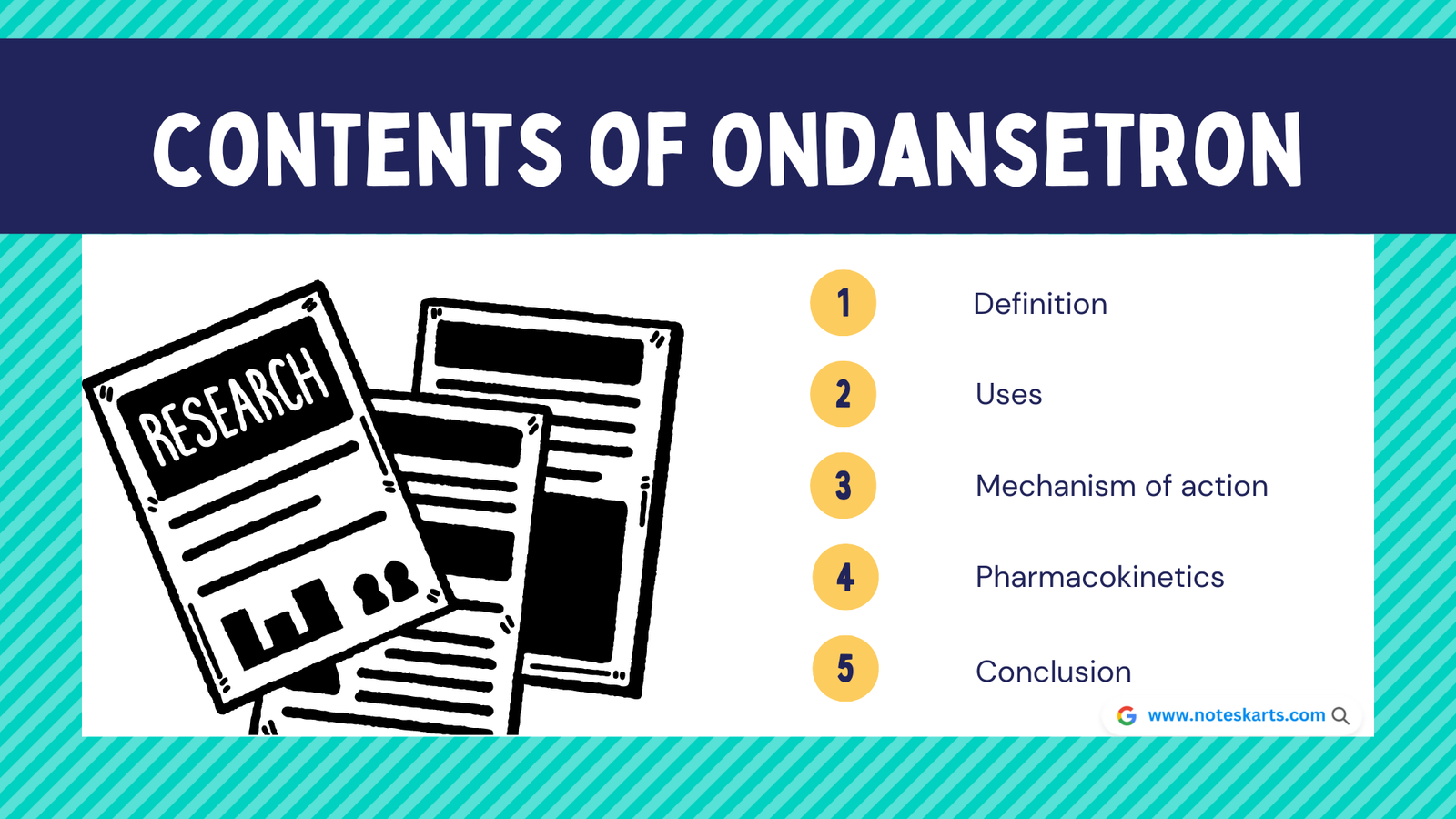Ondansetron: Understanding Its Uses, Mechanism of action, Pharmacokinetics of ondansetron, Dosage of Ondansetron and Side Effects
Introduction—
- Ondansetron is one of the medications used frequently to treat or come down the nausea and vomiting feelings or conditions. Ondansetron placed in the category of the antiemetic drugs (which prevent the emesis). Nausea is usually defined as the inclination to vomit or as a feeling in the throat or epigastric region alerting an individual that vomiting is imminent. Vomiting is defined as the ejection or expulsion of gastric contents through the mouth, often requiring a forceful event.
- Nausea and vomiting induced due to undesirable intake like smell, taste, and touch. It also occurs due to accident, indigestion, gastric irritation, fear, motion sickness, pregnancy and some of the disease condition. Commonly arises due to chemotherapy-induced and radiation induced. Ondansetron prevents the nausea and vomiting feeling by taking separately (single) or with the combination of other medicinal chemical composition. Generally, In market ondansetron present in mouth dissolving (MD) tablet form.
- The three consecutive phases of emesis include nausea, retching, and vomiting. Nausea, the imminent need to vomit, is associated with gastric stasis. Retching is the laboured movement of abdominal and thoracic muscles before vomiting. The final phase of emesis is vomiting, the forceful expulsion of gastric contents due to GI retro peristalsis.
Indications/Uses of Ondansetron.
- Chemotherapy-induced nausea and vomiting (CINV).
- Radiation-induced nausea and vomiting (RINV).
- It also used to prevent the nauseating feeling arises due to the undesirable smell, taste, and touch (food, dead tissue, wound, raw fruits etc).
- Some extent, also used to prevent the pregnancy nauseatic condition.
- Commonly prescribe to the people who having the motion sickness (nauseatic feeling during the travelling).
- In accident and the fear condition ondansetron are also used.
- During the indigestion or gastric impairments ondansetron commonly prescribe to calm down the nausea and vomiting feeling.
Effectiveness of Ondansetron/Mechanism of action:
Ondansetron is a selective 5-HT3 serotonin-receptor antagonist (5-hydroxytryptamine) used for managing the nausea and vomiting feeling (antiemetic properties). It is one of the four FDA-approved 5-HT3 serotonin-receptor antagonists including granisetron, dolasetron, and the second-generation drug, palonosetron. Ondansetron acts both centrally and peripherally.
Centrally action | Peripherally action |
| It is mediated by the antagonism of 5HT3 serotonin receptors in the area postrema. The area postrema, located on the fourth ventricle floor, contains the “chemoreceptor trigger zone.”(CTZ). This zone senses neurotransmitters like serotonin, toxins, and other signals and plays a role in mediating the sensation of nausea and subsequent vomiting. | Peripherally it acts on the vagus nerve. It works on the 5-HT3 receptors that can be found at the vagus nerve terminals. The vagus nerve can sense nausea and vomiting triggers within the GI tract, such as stomach irritants. It forms synapses within the nucleus tractus solitarius of the brainstem, another region important in vomiting. The peripheral actions of ondansetron are thought to be the predominant mechanism for its antiemetic effects. |
| Pharmacokinetics of ondansetron | |
| Absorption | Ondansetron undergoes rapid absorption from the GI tract, and the peak plasma concentration (Tmax) is approximately 1.5 hours after an 8 mg single oral dose. The absolute bioavailability of ondansetron after oral administration is approximately (50%-70%). The bioavailability of ondansetron is significantly higher in cancer patient than in healthy individuals. |
| Distribution | Ondansetron and its metabolites are extensively distributed in tissues. The apparent volume of distribution (Vd) at a steady state is approximately 1.8 L/kg. Ondansetron crosses the blood-brain barrier to a lower extent, with the CSF concentration only about 10%-15% of the plasma concentration in human individuals. |
| Metabolism | The liver is the primary site of metabolism. The primary mechanism of metabolism is oxidation. 8-hydroxy ondansetron represents the major metabolite (40%), followed by 7-hydroxy ondansetron (< 20%) and 6-hydroxy ondansetron (<5%). The active metabolite of ondansetron is 8-hydroxy ondansetron which is rapidly metabolized to glucuronide and sulphate conjugates in the liver. Minor metabolism also occurs via N-demethylation to yield N-dimethyl ondansetron. |
| Excretion | Average 90 % of ondansetron metabolise as hepatic metabolism and less than 5% is excreted unchanged in the urine. |
Side Effects of Ondansetron:
The most common side effects associated with these agents are constipation, headache, and asthenia. By rapid intravenous administration ondansetron can produce significant hypotension with tachycardia that can lead to syncopal episodes in awake patients. Abnormal bowel function (constipation more often than diarrhoea), seizure activity and excessive fatigue and weakness have also been associated with ondansetron. Ondansetron also hampered the GABA and glycine receptor activity in some of the cases.
Formulation of Ondansetron:
Tablet, injection, oral drop, syrup, solution, suspension, disintegrating strip, sachet.
Dosage of Ondansetron:
| Adult dosage | |
| Oral | 8 mg TID or 8 mg BID for 3days |
| Intravenous | 4-8 mg every 8 hours |
| Paediatric dosage | |
| Oral | 4 mg aged about 4-11 years (infants 0.15 mg/kg) |
| Intravenous | Children and adolescents 0.15 mg/kg. |
Brand name of ondansetron:
- Vomikind, zofer, eterna, ondem, emeset, vomiford, ranidom on, Zofran, vomikind fast,
Pregnancy and Ondansetron:
Ondansetron is a former FDA “Pregnancy Category B” drug. It should only be used when other medications have been trialed and failed to treat pregnancy-associated nausea, vomiting, and hyperemesis gravidarum. According to ACOG (The American College of Obstetricians and Gynaecologists) guidelines, pyridoxine alone or combined with doxylamine is the preferred pharmacological therapy for nausea and vomiting. Recommendations for pregnant women with gynaecological cancer suggest that 5HT3 antagonists (including ondansetron) can be used as supportive medication.
Conclusion:
Ondansetron is one of the four FDA-approved 5-HT3 serotonin-receptor antagonists including granisetron, dolasetron, and the second-generation drug, palonosetron. Now a days, commonly it is used as the OTC (over the counter) medication by the consumer. Ondansetron, is present in the form of mouth dissolving (MD) tablets in the market which are directly absorb in the mouth and show the rapid effects
Read More Article

